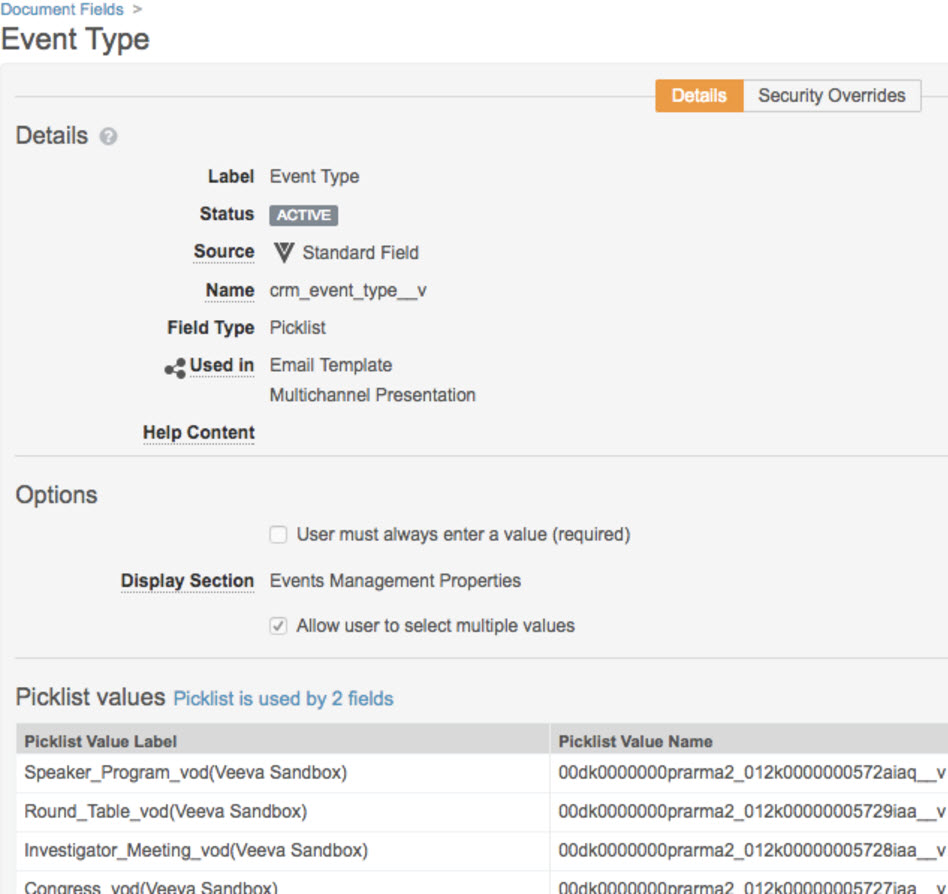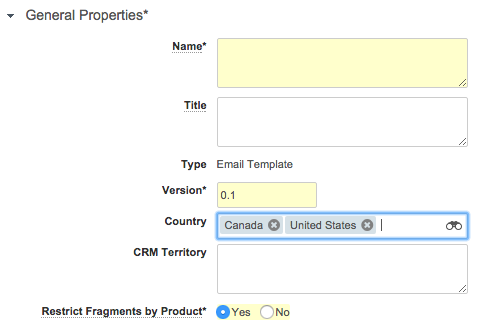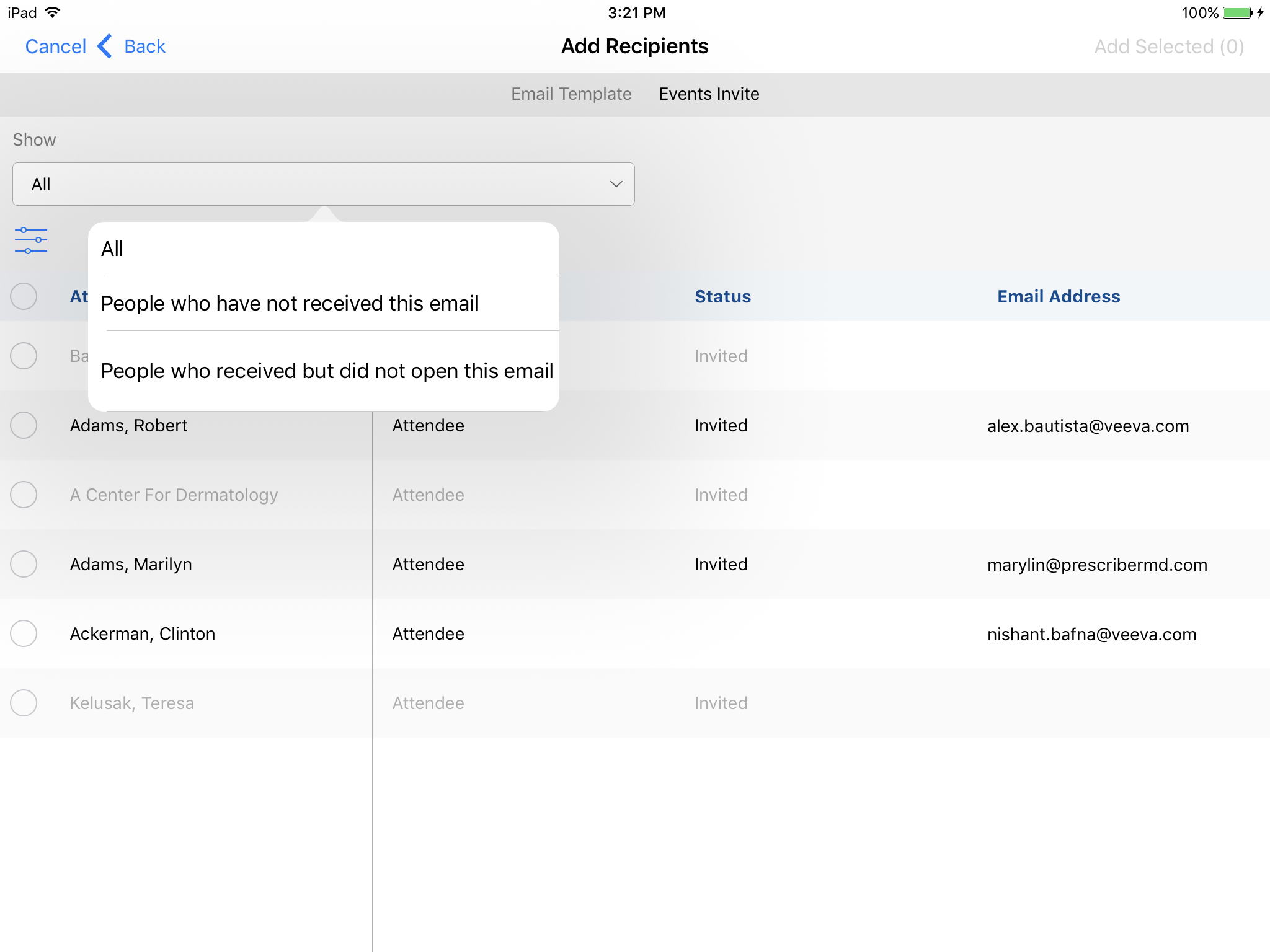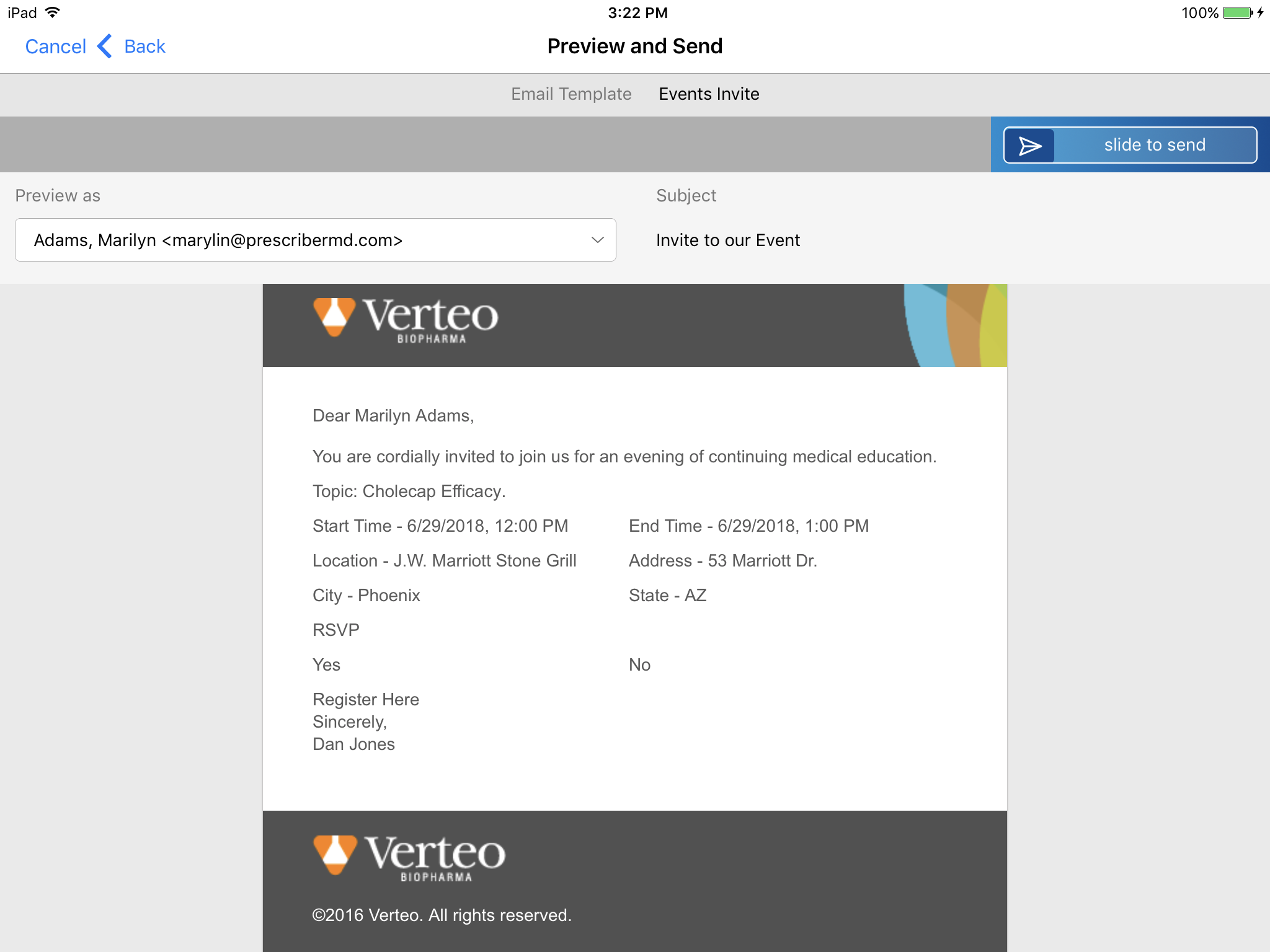Using Approved Email for Events Management
- Browser
- iPad
Events Management users are able to use Approved Email as a form of communication with attendees of an event for a variety of reasons, including:
- Official invitations to an event
- Save the Date notes to potential attendees for an event
- Updates on event details
- Reminders
- Follow-up material
Content Administrators can create and approve new Email Templates in Vault and indicate which event types, countries, and topics the templates are valid for. CRM users can then create events, select the appropriate template, and send emails to recipients who can take action, if necessary.
After creating an Event, the email templates are associated to the Event via the Event Materials. The Event Material records are generated automatically when creating the event based on the event’s type, country, and topic.
It is possible to add RSVP links to an email template, or include a link to a registration portal. RSVP is only available for Event Attendees. Team Members and speakers who are not Event Attendees cannot RSVP.
Considerations
Approved Email for Events Management does not support the following:
- Managing Email Address of Recipients in the Recipient Selector UI
- Updating Consent of Recipients from the Recipient Selector UI
- Free Rich Text in Approved Email Content
- Ability to schedule an Approved Email for an Event
Configuring Approved Email for Events Management
To enable Approved Email for Events Management:
- Ensure end users have the appropriate Approved Email permissions. See Approved Email for more information.
-
Grant admins and the integration user the following permissions:
Object
OLS
Record Types
Fields
FLS
Approved_Document_vod CRUD Events_Management_vod - Event_Management_Subtype_vod
Edit EM_Event_Material_vod CRUD Email_Template_vod - Email_Template_vod
- Subtype_vod
Edit EM_Event_Rule_vod CRUD n/a Email_Template_vod Edit EM_Topic_Material_vod
CRUD n/a
Email_Template_vod Edit
Metadata_Definition_vod CRUD Event_Type_vod Record_Type_vod Edit Metadata_Translation_vod
CRUD Event_Type_vod
n/a
n/a
Sent_Email_vod CRUD Events_Management_vod - EM_Event_vod
- Medical_Event_vod
- EM_Attendee_vod
- Event_Attendee_vod
- EM_Event_Team_Member_vod
- EM_Event_Speaker_vod
- User_vod
- Events_Management_Subtype_vod
- Capture_Datetime_vod
Edit -
Grant end users the following permissions:
Object
OLS
Record Types
Fields
FLS
Approved_Document_vod RU Events_Management_vod - Event_Management_Subtype_vod
Edit EM_Event_Material_vod RU Email_Template_vod - Email_Template_vod
- Subtype_vod
Edit EM_Event_Rule_vod RU Email_Template_vod Edit EM_Topic_Material_vod
RU
Email_Template_vod Edit
Metadata_Definition_vod R Event_Type_vod n/a n/a Metadata_Translation_vod
R
Event_Type_vod
n/a
n/a
Sent_Email_vod RU Events_Management_vod - EM_Event_vod
- Medical_Event_vod
- EM_Attendee_vod
- Event_Attendee_vod
- EM_Event_Team_Member_vod
- EM_Event_Speaker_vod
- User_vod
- Events_Management_Subtype_vod
- Capture_Datetime_vod
Edit - Add the Send_Email_vod button to the Visible Buttons field on the Event Layout record that determines which page layout is displays.
-
Grant admin users and the integration user access to the following Visualforce pages:
- Events_Management_Approved_Email_vod
- Approved_Email_Admin_vod
- Events Management Configuration Console
- Enter in the credentials for Vault and CRM integration users in the Approved Email Administration tab.
- Enable the Events Management Integration setting In Vault.
To enable RSVPs within an email:
-
Grant admins, integration users, and content admins the following permissions:
Object OLS Record Types Fields FLS Multichannel_Message_vod
CRUD
Events_Management_Action_vod
Message_Identifier_vod
- HTML_Message_vod
- Event_Attendee_Status_vod
- Consent_Confirm_HTML_vod [optional]
edit
-
Grant end users the following permissions:
Object OLS Record Types Fields FLS Multichannel_Message_vod
R
Approved_Email_Action_vod
Message_Identifier_vod
- HTML_Message_vod
- Event_Attendee_Status_vod
- Consent_Confirm_HTML_vod [optional]
edit
Integration from CRM to Vault
Approved Email for Events Management uses an integration with Vault. This integration pushes the list of Event Types and Event Topics from CRM to Vault. When creating an Approved Email Template in Vault, the content administrator can select which Event Types and Event Topics the template is valid for. Once the template is pushed to CRM, Event Rule records are created to capture which Event Types and countries the template is valid for. Topic Material records are created to capture which Event Topics the template is valid for.
Log a support case to enable Events Management Integration in your Vault. Once enabled, the new Events Management VOFs and fields display in the Email Template information section on the Events Management Properties sub-section.
To set up the integration, enter credentials for Vault and CRM integration users on the Approved Email Administration tab.
Select the Incremental Refresh button in the Refresh Administration section to extract all Event Types and Event Topics from CRM and push the data to Vault.
Event Types are pushed into the crm_event_type__v picklist in Vault. The picklist label includes the Event Type (generated from the record type on the EM_Event_vod) and the org name. This allows customers to specify where the template is valid in the case that several CRM environments are pointing to a single Vault. Only active record types are pushed to Vault.
Record type translations are not supported through the integration and must be updated manually by modifying the translation in Vault.
CRM Event Types are specified as record types on the EM_Event Object. These are mapped to the crm_event_type__v picklist in Vault:

Event Topics are also pushed from CRM to Vault. Event Topics are stored in the EM_Catalog_vod object using the Event_Topic_vod record type. In Vault, they are stored in the crm_event_topic__v object. Only topics with a status of Approved are pushed to Vault.
The Name_vod field is required in order for EM_Catalog_vod records to push to Vault.

Event Topic names in CRM can be up to 255 characters long. In Vault, the Event Topic name can only be 128 characters long. To allow for the full topic name to display, an additional field full_name__v is used in Vault.
Setting up Templates
Once the integration has run and CRM Event Types and Topics are available in Vault, the content admin can use these attributes to determine when an email template should be made available. Templates are defined in Vault using the Events Management subtype.
In Vault:
-
Create an Email Template:

-
Set the Email Template Type to Events Management Invite Template on the document details:

-
Select the Email Template Subtype, Event Types, and Event Topics in the Events Management Properties section. This drives usage and availability of the template in CRM.

-
Select Countries for which the template is available in the General Properties section.

Email Template Tokens
Content Administrators are responsible for creating and managing Email Templates. See Email Templates for more information.
The following Approved Email Configuration Tokens are supported for content used for Events Management purposes:
- {{accCredentials}} – Displays the account's credentials
- {{accFname}} – Displays the account's first name
- {{accLname}} – Displays the account's last name
- {{accTitle}} – Displays the account's title
- {{addToCalendar}} – Inserts an .ICS attachment into the email
-
{{customContent}}
This token is only supported in emails sent to in-territory recipients.
- {{customText()}}
- {{$VaultDocID}} – Generates a link to a PromoMat Vault document
- {{emailTemplateFragment}} – Defines a section in the footer where Email Fragments are inserted
- {{insertEmailFragments}} – Defines a section in the template where Email Fragments are inserted
- {{ObjectAPIName.FieldAPIName}} – Limited to the following objects:
- EM_Event_vod
- EM_Attendee_vod – Only as a recipient
- EM_Event_Speaker_vod – Only as a recipient
- EM_Event_Team_Member_vod – Only as a recipient
- {{ObjectAPIName.RelationshipName.FieldAPIName}} – Limited to the following objects:
- EM_Event_vod
- EM_Attendee_vod – Only as a recipient
- EM_Event_Speaker_vod – Only as a recipient
- EM_Event_Team_Member_vod – Only as a recipient
- EM_Speaker_vod – Only available as the middle RelationshipName parameter
- EM_Catalog_vod – Only available as the middle RelationshipName parameter
- {{approvedEmailAction}} – Tokens that create a link in the email
- {{ISILink}} – Generates a link to an Important Safety Information Vault document
- {{timeZone}} – Displays the time zone of the device
- {{userEmailAddress}} – Displays the user's email
- {{userName}} – Displays the user's name
- {{userPhoto}} – Displays the user's photo, if available
- {{unsubscribe_product_link[External URL,Value of the appropriate Unsibscribe_Identifier_vod field]}} – See Adding and Customizing Unsubscribe Links for more information
- {{PieceLink}} – Generates a link to a Related Piece Vault document
- {{PILink}} – Generates a link to a Prescribing Information Vault document
Event Speaker and Event Catalog Objects in Relationship Tokens
Content creators can reference relationships between two disconnected objects, EM_Speaker_vod and EM_Catalog_vod, using the relationship Approved Email token. This enables greater flexibility when creating Approved Email content to use in Events Management.
For example, Alice Adams wants to edit an Approved Email template used as an invitation to events to reference the name of the event’s topic per the associated EM_Catalog_vod record. The Topic_vod field on the EM_Event_vod object references the EM_Catalog_vod object, so she adds the following token to the email template to reference the topic name:
{{EM_Event_vod__c.Topic_vod__r.Name_vod__c}}
To configure this feature, add the appropriate {{ObjectAPIName.RelationshipName.FieldAPIName}} token to the appropriate Approved Email Templates.
Adding RSVP Links
Content Administrators can add RSVP links to templates by creating Multichannel_Message_vod records and referencing those records in the email template.
|
Name |
RecordType |
Message_Identifier_vod |
Event_Attendee_Status_vod |
HTML_Message_vod |
|---|---|---|---|---|
|
Event Accept |
Events_Management_Action_vod |
Event_Accept |
Accept_vod |
<html><body><header><h3><span class="hidden">Your response 'Accept' has been saved.</span></h3> </header></body></html> |
|
Event Reject |
Events_Management_Action_vod |
Event_Reject |
Reject_vod |
<html><body><header><h3><span class="hidden">Your response 'Reject' has been saved.</span></h3> </header></body></html> |
|
Event Maybe |
Events_Management_Action_vod |
Event_Maybe |
Maybe_vod |
<html><body><header><h3><span class="hidden">Your response 'Maybe' has been saved.</span></h3> </header></body></html> |
RSVP links redirect to a customer-defined landing page using the following format:
<a href={{approvedEmailAction[CUSTOMER LANDING PAGE,RSVP IDENTIFIER]}}></a>
for example, if the landing page is hosted on https://example.com and selecting the link registers the recipient response as Yes, the link would be:
<a href={{approvedEmailAction[https://example.com,Event_Accept]}}>Yes</a>
Customer-hosted landing pages for RSVP links should contain the HTML defined by the HTML_Message_vod field for the appropriate action, as well as the following JavaScript snippet:
<div align="center" id="multichannelmessage"> </div>
<!-- The iFrame and Multichannel Message Page will replace the above <div> tag. Please note that the id of the <div> matches the first parameter of the constructor -->
<script>
var tag = document.createElement('script');
tag.src = "//cdnmc1.vod309.com/multichannel/veeva/js/externalrequest/embed-multichannelmessage.js";
var firstScriptTag = document.getElementsByTagName('script')[0];
firstScriptTag.parentNode.insertBefore(tag, firstScriptTag);
// This function creates an <iframe> (and multichannelmessage iframe viewer)
// after the API code downloads.
var multichannelMessage;
function onMultichannelMessageAPIReady() {multichannelMessage= new MUL.Frame('multichannelmessage', {height: '600px',width: '80%',});}
</script>If a landing page is not used for the RSVP link, the LandingPageURL parameter may be left blank.
Attaching Calendar Reminders
Approved Email content creators can add the {{addToCalendar}} token to an Email Template to add a .ICS file attachment that recipients can use to add the event to their calendar.
Integration from Vault to CRM
Templates in either Staged or Approved status can be sent to CRM for use from an Event. These templates are imported into the Approved_Document_vod object. Only Content Admins in CRM can send staged content.
There are two mechanisms for sending templates to CRM:
-
From the Approved Email Administration tab, select the “Incremental Refresh” or “Force Full Refresh” buttons. Incremental Refresh only pulles templates to CRM that have been updated since the last refresh.

- From the Approved Email Administration tab, set up the Events Management Process. This process runs both parts of the integration – sending Event Types and Event Topics updates to Vault and pulling email templates from Vault to CRM.
When templates are imported into CRM via integration with Vault, the Event Types, Countries, and Event Topics associated with the template in Vault build configuration rules in the EM_Event_Rule_vod and EM_Topic_Material_vod tables consistent with Event Materials. Configuration records are created in CRM as follows:
- Topic-only configurations - Topic is populated, but Event Type is null in Vault. Country is ignored.
- Only topic materials are created after importing the approved document record
- Event-type-only configurations - Event type is populated, but Countries are null
- Event Rules are created under all Event Configurations where Event_Configuration_vod__c.Event_Type_vod__c = crm_event_type__v.name__v
- There is one rule per Event Configuration Country for the Event Configuration, utilizing the Country Override field
- Event-country-only configurations - Event Type is null, but Countries are populated
- Event Rules are created for all Event Configuration Countries where Event_Configuration_Country_vod__r.Country_vod__c.Alpha_2_Code_vod__c = country__v.abbreviation__vs
- Complete Event Type configurations - Event Type and Country are both populated in Vault
- Event rules are created only for Event Configurations matching one of the Event Types configured on the template for countries that are also specified on the template
- Modification – When data is modified in Vault, the integration deletes records in the Event Rule and Topic Material objects that are no longer valid
- Versioning – When a new version of a template is loaded in Vault, the old version is set to Expired on the CRM Approved Document, and a new Approved Document is created
- The Topic Material and Event Rule records referencing the old version are updated to reference the new version
- Expiration, deletion, or withdrawal
- When content is expired, the corresponding Approved Document record in CRM is set to expired
- The Event Rule and Topic Material records related to the Approved Document remain. However, users are unable to send expired content.
Using Approved Email in Events Management
When creating an Event, users are able to select the appropriate email template based on the Email Templates referenced in the Event Materials related list. This list is created automatically when an event is created or updated, and is based on the countries, topics, and event types selected for the Email Template in Vault. Event organizers can manually add email templates to an event and automatically access the details to send to event participants by selecting the New or + button.
When an event is created or updated, Event Material records are created based on the Event Rule and Topic Material records created by the integration. To learn more see Event Materials. These Event Materials drive which email templates are available when the user attempts to send an email.
If the Send Email button is configured as a Visible Button on the Event_Layout_vod record that controls the displayed page layout, a list of email templates by type displays when selecting the button. The user can then select the appropriate template, add the recipients, and send the email.


The email selection screen includes the date the email was last sent from this event. This helps users identify if an email (such as a save-the-date notice) was sent.
After selecting a template, the user can select from a list of speakers, event team members, or attendees to receive the email.
Adding large numbers of attendees to a single email may cause errors due to excessive query length. If this occurs, reduce the number of attendees until no errors occur.
The recipient selector includes filters to quickly find recipients based on the following:
- Whether or not they received the email
- Whether or not they opened the email
- What type of attendee they are (team member, speaker, or attendee)
- Attendee status (invited, attended, signed, etc)

Consent in Approved Emails for Events Management
Consent is respected for sending invitations for Events Management. If an Account has explicit consent and there are no opt-in records, users are not able to send email. If an Account has implicit consent and there is an opt-out record, users are not able to send email to that Account.
Both product level and content type consent is supported when sending invitations for Events Management. See Creating Consent Lines for more information about creating content type consent.
Users cannot manage consent or email addresses from the recipient selector screen. The recipient must have a valid, consented email address in order to send an email.
Once recipients are selected, the user can preview the template for all recipients and enter data in any configured fields that allow for user inputs.

Restricting Email Recipients by Audience Type
Approved Email for Events Management now supports the ability to designate a target audience type for a given email template. The designation is set in Vault. Allowed audience types are Attendee, Speaker, and Team Member.
For example, Alice Adams' company has separate webinar invitations for speakers and attendees. When setting up the Approved Email invitation in Vault, Alice designates which invitation template should go to which recipient type.
Configuration
To enable this feature:
- Assign the event_audience__v field to Email_Template__v object in Vault.
- Grant Admin users FLS edit permission and end users FLS read permission to the Audience_vod field on the Approved_Document_vod object in CRM.
Use
The Audience column on the Choose Template screen indicates the template purpose. If no audience is set in Vault, the template is available to all user types.

If a template with a specific audience type is selected, the Add Recipients screen displays recipients for only that type.
Sending Approved Emails to Out of Territory Accounts
Event organizers can send Approved Emails to Event Speakers and Event Attendees outside of their territory. This enables users to still send follow-up information to these accounts.
This is only works for Events Management Approved Emails.
Consent is respected when sending Approved Emails to out-of-territory Event Speakers and Event Attendees, however, users are not able to capture consent for accounts outside their territory.
For example, Sarah Jones is responsible for Territory 101 and hosts a lunch and learn. Dr. Bob Adams is assigned to the neighboring territory, Territory 102. He attends Sarah’s event as a walk-in attendee. After the event is over, Sarah is able to send Dr. Adams a follow-up survey using Approved Email, even though he is not an account in her territory.
Enabling Sending Event Approved Emails Out of Territory
To enable this feature for all users sending Approved Emails from Events Management:
- Grant all users FLS edit permission to the Entity_Reference_ID_vod field on the Sent_Email_vod object.
- Grant all users access to the VODAccountSearch Apex class.
Users will not be able to send an email from any Approved Email entry point if one of these items is not configured.
Using
Users can select out-of-territory Event Attendees and out-of-territory Event Speakers as recipients for an Approved Email just as they would for an in-territory recipient, including selecting any email address associated with the out-of-territory recipient and previewing the email.
Offline validation rules are ignored when sending an Approved Email to an out-of-territory attendee or speaker from the iPad. Online validation rules still run when syncing. If the email fails an online validation rule, a Sync Errors and the email is blocked from sending.



